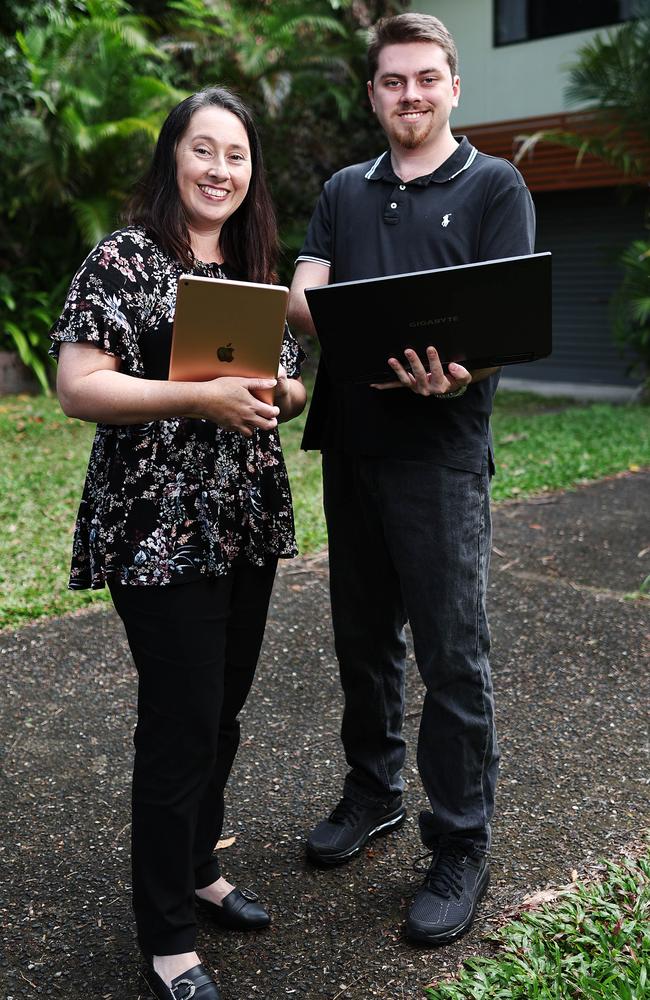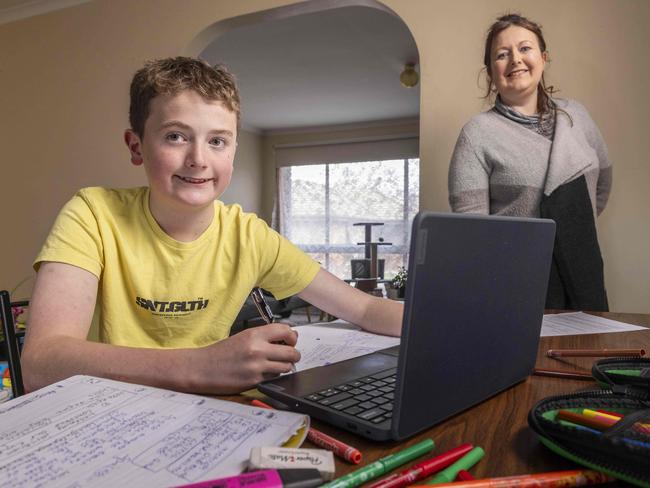Bush Summit 2024: How NBN’s student broadband program works, FTTP coming to 1.4m regional households
A free student broadband program is helping to bridge the digital divide between kids in the bush and children in metropolitan areas.
QLD News
Don't miss out on the headlines from QLD News. Followed categories will be added to My News.
It wasn’t that long ago that we predominantly watched free-to-air television, turned our phones off when boarding a flight and went to an office or workplace to do our jobs.
Cut to a world that now streams television on demand, works from home in increasing numbers and uses smart appliances like Wi-Fi fridges and robotic vacuum cleaners in the home.
This story is part of News Corp Australia’s Bush Summit series celebrating rural and regional Australia and championing the issues that matter most to those living in the bush. You can read all our coverage here
It’s clear that our broadband needs have evolved quickly, and so too must the network that delivers those needs.
Four in five Australian households are connected to the NBN network, including three-quarters in regional Australia. And while the NBN network rollout was completed in 2020, they have now turned their attention to upgrading their system – particularly in regional Australia.
Thousands of regional households are now eligible to upgrade their broadband service, which in most cases requires a switch from copper-based, or fibre-to-the-node (FTTN) technology to full fibre, or fibre-to-the-premises (FTTP) connectivity, which is NBN’s fastest and most reliable connection.
By the end of 2025, around 1.4 million homes and businesses in regional Australia will be eligible to order a FTTP connection upgrade.
“Homes across Australia have different technologies, sometimes fibre, sometimes copper,” explains Gavin Williams, NBN’s chief development officer regional and remote.
“The technology with the most homes connected is copper-based technology, or Fibre-to-the-Node (FTTN), which essentially is like a big cabinet down the street. We then put fibre to that big cabinet and use the old copper down the street into the homes.
“What our upgrade is doing is putting fibre up the street and not connecting every home initially, but enabling the homes that have been passed by that fibre to be able to upgrade to fibre based on particular plans they select, to essentially upgrade to fibre on demand.
“We’re pushing through to enable about 90 per cent of our fixed line customers by the end of 2025 to have that upgrade ability. It’s not just the Bendigos and the Ballarats that we’re connecting, we’re pushing fibre deeper into regional Australia, into regional cities and towns.”
In NSW, the local government areas with the highest number of households and businesses that can order an upgrade right now are Shellharbour on the south coast and Ballina on the north coast. In Victoria, it’s mostly those on the Bass Coast as well as Ballarat that can get upgraded, as can around 100,000 residents in Queensland’s far north coast towns of Cairns and Townsville and Mackay north of Brisbane.
Thousands in Western Australia’s Harvey can now check for upgrades, as well as those in South Australia’s Mount Barker and the Clarence region of Tasmania.

Before they upgraded their service, the Hutchinsons of Cairns panicked every time it rained as it would reduce their broadband speed to almost zero.
Mother Belinda had to make sure everyone got off their devices if she needed to jump online for a work meeting and her son Declan would wait hours for large files to download when studying for his university degree in IT, majoring in cyber security.
“It’s funny, we take it a little bit for granted now that we can all stream on different devices all at once and we don’t have to worry every time it rains, which is quite a bit in Cairns,” Belinda says.
“But then we think back to those days before the upgrade and we are just so grateful we could upgrade.
“While we didn’t have to pay for the actual upgrade or the contractors who came to do
the work, we do have to pay more for the new plan we are on, but Declan is chipping in
so that helps.”
While the network-wide upgrades will change the way so many in regional Australia work and are entertained, our ever-evolving broadband needs mean the NBN providers cannot rest on their laurels and have already turned their attention to future-proofing the network.
The NBN network is competing with new technology, such as Elon Musk’s Starlink satellite broadband service which, while expensive, has already signed up around 200,000 homes and businesses in regional Australia.
But Williams says NBN is already investigating using low earth orbiting (LEO) satellites, like Starlink.
“Our satellite service is supported by two big satellites that sit 36,000km into space,” Williams says.
“But they’ll run out of fuel around 2030. We have a capability that will roll out to that point, but what we have done is ask, when those satellites run out of fuel, what’s an appropriate replacement?
“And part of the replacement includes the fixed wireless service. We’re upgrading that network, which will be completed by December, to lift speeds across the network … and also to expand the coverage of that network to take on more customers that would otherwise be served by our satellite service.
“In respect of the LEO technologies, we’ve put out to market an investigation to start to see whether we can employ those technologies in an appropriate way. That’s a process we kicked off last year.”
CONNECTING OUR REGIONS
Local government areas with access to recent NBN upgrades
NSW – 76,937 households
Ballina
Bathurst
Broken Hill
Dubbo
Muswellbrook
Parkes
Shellharbour
VIC – 80,588
Alpine
Bass Coast
Baw Baw
Ballarat
Mildura
Wodonga
Qld – 124,674
Bundaberg
Cairns
Gympie
Mackay
Townsville
Goondiwindi
WA – 3956
Coolgardie
Harvey
Kellerberrin
SA – 7358
Mount Barker
Tas – 12,070
Break O’Day
Clarence
Northern Midlands
15K FAMILIES MISSING INTERNET UPGRADE
A free student broadband program is helping to bridge the digital divide between kids in the bush and children in metropolitan areas.
The School Student Broadband Initiative can save needy families up to $2000 a year, but while 40 per cent of households taking advantage of the offer are from regional Australia, many more could be using it.
The free service is available for up to 30,000 families feeling cost-of-living pressure, yet only 15,000 have so far taken up the offer.
The program – an Australian government initiative implemented and supported by NBN Co – was recently extended until December 31, 2025.
The initiative was designed to lessen the digital divide among children as classrooms become
increasingly digitised. Gone are the whiteboards and, in many cases, the textbooks and
exercise books that children once used.
Today’s students are expected to have access to the internet at home to research and complete homework and assignments, receive emails from teachers, download textbooks and even order their lunch online.
“We know that children who can access online learning as part of their education are
more likely to be engaged in classroom activities,” NBN Co chief corporate affairs
officer Felicity Ross said. “Access to fast internet at home can also support school students in
building their digital skills, learning how to safely use the internet, and participating
more effectively in the digital economy.
“The SSBI is designed to be inclusive, benefiting school-aged children across Australia in
both regional and metropolitan areas. The goal is to ensure that all students, regardless
of their geographic location, have access to the same high-quality online educational
opportunities – made possible due to fast and reliable broadband via the NBN – and can
fully participate in their digital education.”

Single mother Kara Goldsmith and her son, Jakob Woolf, 12 of Ballarat, suffered through
the longest pandemic lockdowns in the world without broadband internet in their
home. Instead Goldsmith paid for a costly dongle so Jakob could access online
classrooms while home schooling, which added significantly to cost of living pressures.
Earlier this year, while searching on his mum’s phone, Jakob found out about the SSBI
and made the call to the National Referral Centre himself. Goldsmith said they had
broadband internet operating in their home within a day.
“With all the increasing costs and pressures and being a single-income family, this free
broadband has been a real blessing,” Goldsmith said. “The stress of not having to worry
about where the money will come from for that is such a relief.”
Goldsmith added that with Jakob starting high school this year, having access to reliable,
fast, unlimited broadband through the NBN has been essential for her son’s education.
But the social and emotional support a digital connection provides a family cannot be
ignored.
“My son’s father passed away recently and the internet has been an escape for him,” she
said. “Just the ability for him to connect with his peers online and even play games
online has been a real saviour for him through this difficult time.
“We both also use our home internet to speak to psychologists online. Really, the
benefits have been endless.”
It’s essential for children to be able to learn on a level playing field, and in this day, that
means having access to reliable home broadband, communications minister Michelle
Rowland said.
“Our children have grown up in a world where their educational, social and economic
opportunities depend on digital inclusion, digital skills and literacy,” Rowland said.
“Learning does not end in the classroom and classrooms are no longer confined to
school grounds.
“The Albanese Government will not let circumstance be a barrier to digital inclusion,
access to education or essential services. This is what our School Student Broadband
Initiative is all about – providing free home broadband for school kids who would
otherwise go without.”
Ross says NBN have been working with 60 nominating organisations as well as
supporting the National Referral Centre, which is operated by Anglicare Victoria, to help
make it as easy as possible for families to check if they are eligible and connect.
Eligible families must have a child living at home enrolled in an Australian school, get
referred by a nominating organisation, or self-refer through the National Referral
Centre, and have no active NBN broadband service. They must also live in a home that
can access a standard NBN service.
Applications for SSBI are set to close on December 31, 2024.
To check your eligibility, contact Anglicare Victoria’s National Referral Centre on 1800
954 610 or visit anglicarevic.org.au/student-internet
Originally published as Bush Summit 2024: How NBN’s student broadband program works, FTTP coming to 1.4m regional households


